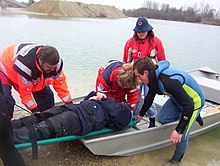Water saver
A water rescuer is a person who is active in the water rescue service and who has normally completed further training than that of a lifeguard .
Water rescuer at the water watch
At the water rescue service in the DRK , the silver lifeguard badge is the minimum qualification for active lifeguards . With the medical training A and B you are a lifeguard in the water rescue service . Since 2001 there has been further training to become a water rescuer (formerly SAN C water rescue service ). This is a prerequisite for some further training (e.g. as a rescue diver or a motorboat driver ).
During the training, the prospective water rescuers receive an introduction to the Medical Devices Act and radio instruction and advanced medical training specially adapted to the water rescue service. Particular emphasis is placed on possible use scenarios as a water saver, for example with an introduction to diving medicine , cardiopulmonary resuscitation or hypothermia . In the practical training, among other things, rescue techniques in interaction with motor lifeboats, search techniques and use in flowing waters are taught. In addition, an introduction to operational tactics is given. The knowledge of the operational material for the water rescue service is deepened by practical case studies on the water. The course ends with a written and practical exam.
Water rescuer at the DLRG
At the Deutsche Lebens-Rettungs-Gesellschaft , a water rescuer is a graduate of specialist training in water rescue services . The specialist training in the water rescue service is designed as basic training for all areas of emergency services within the DLRG. It is a prerequisite for further training as a watchman, boat driver, mission diver, flow rescuer and for civil protection training. At the same time, its modular structure is intended to facilitate the integration of young people and their introduction to the emergency services.
The specialist training in water rescue service is a training that is divided into basic training and advanced training. Basic training includes the German silver lifeguard badge and a first aid course . The Advanced Training includes not only a medical course , a snorkel dive training and a voice instruction more smaller units to organize, conduct on lifeboats and the like. The subsequent examination consists of a written and three practical parts: a lifeguard exercise, a medical exercise and an exercise on behavior in action. In total, the training comprises around 160 teaching units.
From the age of 16, young lifeguards can take the water rescue service exam after taking part in all training courses and from this point on can be employed independently as qualified water rescuers in the water rescue service on the German coasts, inland waters or in swimming pools.
Water rescuers in Switzerland
In Switzerland, you must have at least a valid Brevet I from the Swiss Lifesaving Society or an equivalent qualification to work as a water rescuer. From the age of 16 you can work in a swimming pool with this training. In the swimming pools in Switzerland a clear distinction is made between pool supervisors and supervisors, whereby the supervisors consist of the water rescuers with a lifeguard certificate and the pool supervisors have mostly attended further training.
Water rescuers in Austria
In Austria there is a river rescuer (FW-R) and further training to become a whitewater rescuer (WW-R).
The training to become a flowing water rescuer is a further training of the Austrian water rescue . It can be completed by members of the ÖWR if they have reached the age of 18, have a lifeguard badge and their first aid course is not older than three years.
The examination conditions for the running water rescuer are water and material science as well as a comprehensive practice in which the basic techniques of swimming, jumping, moving on and in flowing water, knot science and panic lock must be mastered as well as various signs and signals (e.g. danger signs and symbols, to navigation and hands), and backup, rescue and recovery techniques (eg. B .: rescue handles ).
If necessary, additional techniques can be learned such as passive abseiling or a raft trip with an explanation of the paddling techniques.
The training is a prerequisite for training as a white water rescuer .
Individual evidence
- ↑ http://www.wasserwacht-mainparksee.de/Downloads/downloads_Dienstvorschrift_2008.pdf Service regulations for the water rescue service, s. Section 4
- ↑ http://www.wasserwacht-mainparksee.de/Downloads/downloads_APV_Wasserretter.pdf
